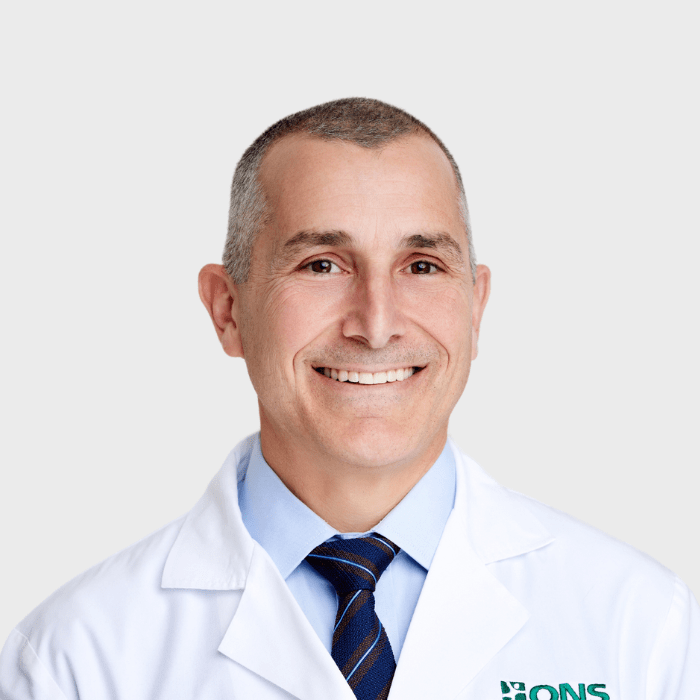
Featured Doctor
Marc S. Kowalsky, MD
Get to know Dr. Marc Kowalsky, a sports medicine specialist and knee, shoulder, and elbow surgeon at ONS.
View Profile

Shoulder arthritis and severe rotator cuff damage can lead to chronic pain and limited mobility. In this Q&A, ONS sports medicine and shoulder surgeon Dr. Marc Kowalsky discusses how modern shoulder replacement techniques—both anatomic and reverse—are restoring function, relieving pain, and helping patients return to the activities they enjoy.
Do I need a shoulder replacement?
If you are experiencing shoulder pain either due to arthritis, chronic damage (such as a rotator cuff tear) or a previous injury, you might need a shoulder replacement. The pain from arthritis or chronic damage to the rotator cuff usually occurs both with activity and at rest – including at night. Arthritis is often associated with loss of motion, and chronic rotator cuff tears often result in overall weakness. While these problems often occur in isolation, certain patients may develop both arthritis and chronic rotator cuff damage together.
What conservative treatments can I try first?
Anti-inflammatory medication, physical therapy, and for some patients injections (such as cortisone, gel, or platelets), can be very beneficial for certain patients with mild or moderate arthritis. Some people might be willing to make lifestyle modifications that will help reduce the pain.
What are total shoulder replacement and reverse total shoulder replacement?
While the broad-brush strokes are similar, in each procedure the design and function of the implants are different. The shoulder joint is formed by the connection of a very large ball at the upper end of the humerus and a shallow, flat socket at the end of the shoulder blade, or scapula. The total (anatomic) replacement keeps the location of ball and socket the same, and relies on the soft tissues including the rotator cuff to provide stability and function for the shoulder joint. The reverse replacement changes the mechanics of the shoulder by actually flipping the ball and socket, so that the socket is at the end of the humerus, and the ball is located at the glenoid cavity. This creates a more stable, constrained design that does not rely on the rotator cuff, which may be torn or dysfunctional in patients undergoing this procedure.
Who is a candidate for total shoulder replacement?
An anatomic total shoulder replacement is recommended for someone who has an intact rotator cuff and arthritis of the ball and socket. It’s imperative that the rotator cuff is healthy to be a good candidate for this surgery.
Who is a candidate for a reverse shoulder replacement?
Because the rotator cuff must be intact for a patient to be candidate for an anatomic shoulder replacement, a reverse shoulder replacement is performed if patient has arthritis together with a torn rotator cuff. A reverse replacement is also considered in other situations, including isolated rotator cuff tears that cannot be repaired and cause significant pain and weakness; complex fractures of the upper part of the humerus, and in patients who require revision shoulder replacement.
What does recovery after surgery look like?
For the first 4-6 weeks, patients will be in a sling and doing some gentle motion. We often don’t start physical therapy right away. Rehabilitation exercises often begin a few weeks after surgery. Patients will first work on range of motion and then gradually build strength. While patients often feel much better compared to before surgery within 2-3 months, significant improvement in motion and strength can take several months. Patients typically get back to their previous level of activity after about 5-6 months
Will my pain be gone immediately?
In general, this is a very successful surgery with a proven track record of being as safe if not safer than hip and knee replacement. Aside from any minor surgical pain, typically the reduction in pre-operative pain is significant shortly after the procedure. Also, patients often recover faster from shoulder replacements than from rotator cuff repairs. This is an extremely effective procedure for pain relief as well as restoration of mobility and function of an arthritic shoulder.
Is shoulder replacement surgery considered an open procedure?
Yes – there will be a single incision in front of the shoulder.
Is shoulder replacement surgery usually done as an outpatient procedure?
Yes, shoulder replacement surgery can be performed as an outpatient procedure for most patients. Thankfully, there is minimal blood loss with typical primary shoulder replacement, there are no routine postoperative blood tests required, and a regional nerve block provides complete pain relief for at least 18-24 hours. Therefore, inpatient care is truly not necessary for a typical shoulder replacement. Whether or not it’s done on an outpatient basis depends on several factors, including your overall health, age, activity level, and whether you have any underlying medical conditions.
Patients who are generally healthy, have appropriate support at home, and are able to follow post-operative care instructions may be good candidates for same-day discharge. Advances in surgical techniques, anesthesia, and pain management have made outpatient shoulder replacement both safe and effective for many individuals.
However, some patients may still benefit from an overnight hospital stay for closer monitoring, especially if they have other health concerns or require additional assistance during recovery.
Your surgeon will discuss the best option for you based on your specific needs and medical history.
Are there any new innovations in shoulder replacement?
It’s an exciting time in the field of shoulder surgery. Advances in technology have significantly improved pre-operative planning, allowing surgeons to simulate the procedure before entering the operating room to ensure that implants are the right size and precisely positioned for each patient. The ability to design custom implants tailored to each patient’s anatomy has truly been a game changer.
As robotics become more widely used in hip and knee surgeries, we are starting to explore how to incorporate similar technology into shoulder surgeries in the future.






